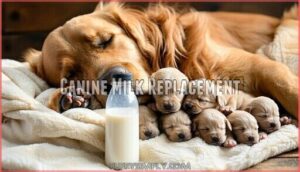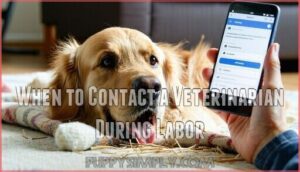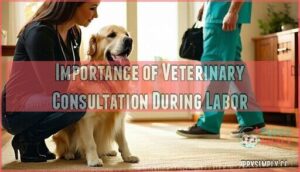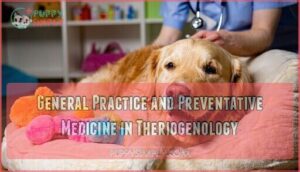This site is supported by our readers. We may earn a commission, at no cost to you, if you purchase through links.
 When you’re expecting puppies, recognizing dog labor signs can mean the difference between a smooth delivery and a frantic scramble.
When you’re expecting puppies, recognizing dog labor signs can mean the difference between a smooth delivery and a frantic scramble.
Your pregnant pup will start showing telltale behaviors like restless pacing, nesting in quiet corners, and a noticeable temperature drop below 100°F.
She might suddenly cling to you like velcro or disappear to find her perfect hiding spot. Some dogs experience morning sickness-style vomiting during early labor.
These changes typically appear 12-24 hours before active labor begins, giving you precious time to prepare. Understanding these subtle signals helps you stay calm and ready, but there’s more to successful whelping preparation.
Recognizing these signs is crucial, as it allows you to be prepared for the smooth delivery and avoid a frantic scramble.
Table Of Contents
- Key Takeaways
- Signs of Dog Labor
- What Are The Signs of a Dog in Labor?
- Essential Items for Dog Labor
- When to Contact a Veterinarian During Labor
- Importance of Veterinary Consultation During Labor
- Importance of Having Veterinarian’s Number Handy
- General Practice and Preventative Medicine in Theriogenology
- Proper Care During Pregnancy
- Labor and Delivery Stages and Care
- Frequently Asked Questions (FAQs)
- What are the signs of a dog going into labor?
- How can a dog’s body temperature indicate labor?
- What should owners avoid doing during a dog’s labor?
- What are the first signs of labour in dogs?
- How do dogs act when labor is near?
- What does stage 1 of dog labor look like?
- How do I know how close my dog is to giving birth?
- What is the average length of gestation for dogs?
- What are the signs of a false pregnancy in a dog?
- What nutritional considerations should be taken into account during a dog’s pregnancy?
- Conclusion
Key Takeaways
- Watch for your dog’s body temperature to drop below 100°F—this reliable indicator signals labor will begin within 12-24 hours and gives you time to prepare.
- Notice nesting behaviors like rearranging blankets, seeking quiet spaces, or becoming clingy, as these instinctual actions show your dog’s preparing for delivery.
- Prepare essential supplies including a whelping box, clean blankets, heat lamp, bulb syringe, and your vet’s phone number before labor starts.
- Contact your veterinarian immediately if you see prolonged straining without puppies, more than one hour between births, or signs of severe distress during delivery.
Signs of Dog Labor
Spotting early labor signs in your dog can feel like deciphering a secret code.
Like cracking nature’s delivery code, your dog’s body speaks through subtle signals when puppies are ready to arrive.
Nesting behavior, like rearranging blankets obsessively, is a telltale whelping sign.
A sudden drop in appetite, shivering, or even vomiting might also pop up.
Watch for active labor signs like visible dog contractions or licking around the genital area.
A hardened belly signals the birthing stages are near.
Gestation averages 63 days, though breed variations exist.
Stay alert—recognizing these dog labor signs early guarantees smoother whelping preparation and postpartum care for both mom and pups.
What Are The Signs of a Dog in Labor?
Knowing the signs of labor in your dog can help you prepare for a smooth delivery.
From nesting to a sudden drop in body temperature, these clues signal it’s almost time to meet the puppies.
Nesting
As labor approaches, your dog’s instincts kick in, and you’ll notice her engaging in instinctual nesting.
She might start rearranging blankets, digging at her bed, or choosing a quiet nest location.
This nesting behavior is her way of preparing a safe, cozy space for her puppies.
Think of it as her version of decorating a nursery!
If she seems restless or focused on nest preparation, it’s her way of reducing anxiety and making comfort a priority.
Keep her whelping area ready and stocked with clean blankets to support her efforts.
Dog labor signs of nesting are a natural, heartwarming part of this process—trust her instincts.
Body Temperature Drop
A dog’s body temperature drop is a key labor sign, signaling her body’s readiness for birth.
Typically, it falls from 101-102.5°F to around 98-99°F within 12-24 hours before labor. Use a digital rectal thermometer for accurate readings, and check daily during the final week.
- Temperature Fluctuation Causes: Hormonal shifts, like declining progesterone, trigger this drop.
- Monitoring Techniques: Take readings at the same time daily, morning or evening.
- Environmental Impact: Keep the room calm, as stress can affect accuracy.
Stay consistent and prepared!
Desire for Human Presence or Solitude
As your dog approaches labor, you might notice a shift in her social habits.
Some dogs seek comfort by staying close to you, craving reassurance, while others prefer isolation, driven by their nesting behavior and instinct to create a safe space.
Anxiety manifestation, like pacing or whining, can also occur.
Breed differences and environmental influence play a role in these preferences, so watch her cues closely.
reassurance
Vomiting
Vomiting can be one of those unexpected dog labor signs that leaves you wondering if everything’s okay.
It’s not uncommon for dogs to vomit as labor nears—it could be their body’s way of clearing out excess fluids or reacting to hormonal changes. However, keep an eye on the frequency and severity. Occasional vomiting might be normal, but repeated or intense episodes could signal an issue needing attention.
Sometimes, vomiting overlaps with other dog pregnancy signs, like restlessness or loss of appetite, so monitoring your dog closely is key.
Make sure your whelping area is ready, and keep essentials like a thermometer and your vet’s number nearby. Prevention starts with preparation, ensuring your dog and her puppies stay safe and healthy.
If you notice specks of blood in the vomit, contact your vet immediately.
Essential Items for Dog Labor
Preparing for your dog’s labor means gathering a few essential items to keep the process smooth and safe.
From a sturdy whelping box to a reliable thermometer, having the right tools on hand can make all the difference.
Whelping Box
When nesting behavior ramps up, a whelping box becomes your dog’s safe haven.
Choose the right size, easy-to-clean materials, and a quiet location. A proper setup requires selecting the right whelping box.
Here’s what to include:
- Soft blankets for comfort.
- Heat lamp to keep puppies warm.
- Bulb syringe for clearing airways.
- Puppy-safe padding for protection.
- Thermometer to monitor temperature changes.
Blanket
After setting up the whelping box, a soft, clean blanket becomes your dog’s sanctuary during labor. It’s more than just fabric—it’s her comfort zone, a warm hug in the midst of all the whelping signs.
Choose a durable material that’s easy to wash because things can get messy. Size matters too; make certain it’s large enough to cover the box but not so bulky that it tangles the puppies. Consider exploring options for a suitable whelping blanket for added comfort.
Here’s a quick guide:
Feature Why It Matters
Remember, a clean, cozy blanket helps your dog focus on giving birth and nurturing her newborns.
Heat Lamp
A heat lamp is a lifesaver during dog labor, keeping newborn puppies warm and safe.
Proper placement is essential for temperature regulation without overheating.
It’s key for whelping signs and energy conservation as your dog progresses through labor stages.
A suitable whelping heat source is essential for the puppies.
- Place the lamp above the whelping box for even warmth.
- Monitor puppy safety to avoid burns or overheating.
- Consider alternative heat sources for energy efficiency.
The use of a heat lamp is crucial for maintaining the right environment, and it is also important to ensure puppy safety.
Bulb Syringe
During dog labor stages, a bulb syringe is a lifesaver for newborn puppy care.
Use it for mucus extraction from their noses and mouths, ensuring clear airways after puppy delivery.
Proper syringe cleaning is essential to avoid aspiration risks, and choose syringe types that are easy to handle and effective.
A clean, working bulb syringe can make all the difference when your dog is giving birth, helping you handle potential dog labor complications smoothly, and it is crucial to stay prepared.
Baby Scale
A baby scale is a must for tracking puppy growth and ensuring they’re thriving after birth. Accurate weight monitoring helps spot issues early, like underfeeding. Use a digital scale for precision and ease.
- Weigh each puppy immediately after birth.
- Track daily weights for growth consistency.
- Note any weight loss or stagnation.
- Keep the scale clean for proper usage to ensure accurate weight monitoring.
Canine Milk Replacement
A baby scale tracks growth, but when milk production lags after your dog gives birth, canine milk replacement steps in.
Choose high-quality Milk Replacer Types with proper Feeding Techniques and a Supplementation Schedule.
Follow Storage Guidelines—refrigerate prepared formula for 24 hours max.
These support puppy care until weaning strategies kick in, ensuring healthy development during whelping’s early challenges.
Canine Bottle Feeder
While canine milk replacement provides the nutrition, you’ll need a proper canine bottle feeder to deliver it safely during whelping.
Professional-grade bottle feeders feature soft, flexible nipples that mimic natural nursing, making the switch easier for struggling puppies. These specialized tools become lifesavers when puppies can’t latch properly or when dog labor signs indicate complications requiring supplemental feeding.
Your bottle feeder setup requires attention to several key factors:
- Feeder sterilization between uses prevents harmful bacteria buildup
- Nipple sizes must match your puppy’s developmental stage and breed
- Feeding frequency every 2-3 hours facilitates proper growth and development
- Milk temperature at 98-100°F mimics mother’s natural warmth
Remember burping puppies gently after feeding, just like human babies. Proper veterinary care guidance helps determine when bottle feeding becomes necessary during puppy care emergencies.
Thermometer
Monitoring your dog’s temperature becomes your compass during labor preparation.
A rectal thermometer provides temperature accuracy that digital thermometers can’t match for detecting the pivotal dog labor temperature drop.
Normal temperature sits between 100-101°F, but watch for the telltale dip to 98°F that signals labor within 24 hours.
Check monitoring frequency every 12 hours as your due date approaches.
This simple tool helps you recognize dog labor signs early, ensuring you’re ready when veterinary care during dog labor becomes necessary.
Veterinarian’s Phone Number
Keep your veterinarian’s phone number saved in your phone and written down where you’ll find it fast.
Dog labor signs can appear suddenly, and emergency situations often happen during after-hours support times.
Quick access to veterinary consultation becomes your lifeline when complications arise, providing emergency situations with the necessary support.
Don’t scramble searching for contact information when veterinary assistance matters most for your dog’s safety.
When to Contact a Veterinarian During Labor
You’ll want to recognize the warning signs that require immediate veterinary attention during your dog’s labor, as some complications can threaten both mother and puppies.
Knowing when to make that vital phone call can mean the difference between a smooth delivery and a medical emergency that requires professional intervention, which is crucial for the health of both the mother and the puppies, making immediate veterinary attention essential.
Unusual Behavior
Your dog’s behavior during labor can shift dramatically, signaling when veterinary help becomes necessary.
Watch for these concerning unusual behaviors that indicate potential complications:
- Extreme anxiety levels paired with excessive panting or trembling beyond normal labor discomfort
- Complete appetite changes including refusing water for extended periods during active labor
- Abnormal seeking solitude where she hides in unsafe locations or becomes completely unresponsive to your presence
Past Birthing Problems
Past birthing problems like dystocia in dogs create significant risks for future deliveries.
If your dog has experienced previous C-sections, stillbirth history, or other dog labor complications, contact your vet immediately when labor begins.
Certain breed predispositions and maternal health issues increase the likelihood of requiring veterinary emergency intervention during whelping, especially for dogs with a history of previous C-sections.
Prolonged Labor
When labor drags on beyond 12 hours, your dog’s facing serious risks.
Prolonged labor often signals uterine inertia, puppy positioning problems, or maternal exhaustion from calcium deficiency.
These labor complications can quickly become a veterinary emergency requiring immediate intervention.
Don’t wait it out—dystocia in dogs demands professional help, and a Cesarean section might save both mother and puppies.
No Puppies After 3 Hours
When three hours pass without any puppy arrivals, you’re facing a serious emergency that demands immediate veterinary intervention.
This prolonged labor often signals dangerous complications like uterine inertia, puppy obstruction, or calcium deficiency. Without prompt action, both mother and puppies face life-threatening risks requiring emergency procedures.
Knowing your local vet’s holiday hours is essential, as emergency pet care might be required.
Critical warning signs during stalled labor include:
- Dystocia in dogs – Complex birthing difficulties requiring professional assessment
- Labor complications – Fetal demise or positioning problems blocking delivery
- Veterinary intervention – Potential need for Cesarean section to save lives
1 Hour Between Puppies
While puppies typically arrive every 20 minutes during normal delivery, gaps exceeding one hour between births signal potential complications requiring immediate veterinary attention.
This extended puppy delivery interval often indicates maternal health issues or problems with puppy presentation.
Breed differences affect dog labor duration, but regardless of size, prolonged delays during puppy birth suggest your dog needs professional help to guarantee safe delivery.
Consistent Straining With No Puppies
When your dog’s pushing hard but no puppies appear, you’re witnessing ineffective pushing or uterine inertia.
This dog labor complication signals puppy obstruction or dystocia causes that need immediate veterinary assistance.
Consistent straining without results means something’s blocking delivery.
Don’t wait—call your vet right away.
These dog labor signs often require emergency C-section to save mom and babies.
Quick action prevents serious complications during this critical time.
Labor Stopping Before All Puppies Are Born
When your dog’s contractions suddenly stop mid-delivery, you’re facing a serious emergency called uterine inertia.
This dog labor complication requires immediate veterinary intervention to prevent life-threatening consequences.
Several obstruction causes can halt labor:
- Puppy size – oversized pups blocking the birth canal
- Calcium deficiency – weakening uterine muscle contractions
- Exhaustion – mother’s energy completely depleted
- Anatomical issues – narrow pelvis preventing passage
Contact your vet immediately for emergency care.
Severe Distress or Pain
Your dog’s labor can take a dangerous turn when you notice excessive vocalization, prolonged straining without results, or green discharge before puppies appear.
If you see a puppy stuck in the birth canal or maternal collapse occurs, contact your vet immediately.
These dog labor signs of distress indicate serious complications requiring professional veterinarian assistance to prevent life-threatening emergencies.
Weak or Stillborn Puppies
Unfortunately, weak or stillborn puppies can occur during dog labor puppy fading situations.
Watch for pale gums, lack of movement, or no breathing within thirty seconds of birth.
Causes of weakness include congenital defects or poor puppy development complications.
Quick resuscitating puppies attempts and immediate neonatal care can save lives, preventing stillbirths through proper puppy health monitoring.
Importance of Veterinary Consultation During Labor
When your dog goes into labor, having professional veterinary guidance isn’t just helpful—it’s potentially life-saving.
Even experienced breeders know that canine labor signs can quickly shift from normal to concerning, and veterinary care during labor provides the expertise you need when complications arise.
Your vet becomes your lifeline during three critical scenarios:
- Emergency C-section decisions – When natural delivery becomes impossible, swift surgical intervention can save both mother and puppies
- Dystocia management – Professional assessment of difficult births prevents prolonged suffering and potential fatalities
- Puppy resuscitation techniques – Expert knowledge of newborn revival methods can mean the difference between life and death
Veterinary support during labor extends beyond just dog labor complications.
Your vet monitors maternal health throughout the process, watching for postpartum complications that mightn’t be obvious to untrained eyes.
They’ll guide you through proper positioning techniques, recognize when intervention is necessary, and provide immediate medical support when every minute counts for your dog’s safety.
Importance of Having Veterinarian’s Number Handy
Regarding dog labor signs, keeping your veterinarian’s emergency contact information within arm’s reach can make all the difference between a smooth delivery and a stressful crisis. You’ll want both their regular number and after-hours contact saved in your phone before your dog’s due date arrives.
Labor complications can develop quickly, requiring immediate veterinary support during labor. Quick assistance becomes essential when you notice prolonged straining, excessive bleeding, or signs of distress.
Here’s what you should have ready:
| Contact Type | Information Needed |
|---|---|
| Primary Vet | Regular hours phone number |
| Emergency Clinic | 24-hour contact information |
| Backup Vet | Alternative veterinary care option |
| Transport Plan | Route to clinic and emergency kit |
Vet availability varies, especially during nights and weekends when many deliveries occur. Don’t assume you’ll remember numbers during stressful moments. Write them down and post them near your whelping area. Having this emergency contact readily available provides peace of mind, knowing professional help for dog labor emergencies and postpartum care is just one phone call away.
General Practice and Preventative Medicine in Theriogenology
Smart preventative care transforms your dog’s breeding journey from stressful guesswork into confident preparation.
Theriogenology combines breeding soundness exams, genetic screening, and vaccination protocols to guarantee healthy outcomes.
Your vet will assess reproductive health through thorough evaluations, checking for structural abnormalities that could complicate dog labor signs.
Nutritional management becomes vital during pregnancy, with specific dietary adjustments supporting both mother and developing puppies.
Pre-breeding health screenings identify potential issues before they become emergencies during canine parturition.
Regular monitoring helps detect early labor signs and guarantees proper whelping conditions.
This proactive approach means you’ll recognize normal dog labor versus complications requiring intervention.
Neonatal care preparation includes understanding puppy development stages and emergency protocols, giving you peace of mind when those first contractions begin.
Proper Care During Pregnancy
Taking care of your pregnant dog requires attention to her changing needs as she approaches delivery.
You’ll need to confirm the pregnancy, adjust her nutrition during the final weeks, prepare a comfortable whelping area, and monitor her temperature for signs that labor is beginning.
This includes adjusting her nutrition and preparing a comfortable whelping area to ensure a safe delivery.
Confirmation of Pregnancy
Getting the green light on your dog’s pregnancy sets the stage for everything that follows.
Your vet can confirm pregnancy through ultrasound timing around day 25-30, hormone testing for relaxin levels, or palpation accuracy between days 28-35.
These methods reveal early signs and help determine how many puppies you’re expecting.
An X-ray becomes more reliable after day 45 when puppy skeletons are visible.
Dog pregnancy confirmation isn’t just about knowing she’s expecting—it’s about understanding dog pregnancy stages so you can prepare properly.
This knowledge helps you recognize labor signs when they appear and makes certain you’re ready for the big day ahead.
Nutritional Needs in Last Trimester
Your dog’s calorie intake should increase by 25-50% during her final trimester to support healthy puppy development.
Focus on high-quality protein sources and consider veterinary-approved supplementation for ideal nutrition.
Maintain proper hydration as water needs rise substantially during dog pregnancy.
Monitor weight management carefully—excessive gain complicates delivery while appetite loss signals potential concerns.
Professional veterinary advice guarantees your dog receives appropriate dog health care throughout this critical period, supporting both mother and developing puppies.
Preparing Whelping Box
After meeting your dog’s nutritional needs, you’ll want to set up the perfect birthing space. Choose a quiet location away from household traffic for your whelping box.
Whelping box size should accommodate your dog’s breed—she needs room to stretch and move comfortably. Line it with washable blankets and towels that you can easily replace between puppies.
Focus on sanitation practices by keeping extra bedding nearby. This preparation supports your dog’s natural nesting behavior while ensuring puppy safety during those critical first hours of life.
Monitoring Body Temperature
After setting up your whelping box, you’ll want to track temperature fluctuations as a reliable predictor of labor. Digital thermometers provide accurate readings when monitoring your dog’s rectal temperature. A significant temperature drop signals impending delivery.
Here’s your temperature monitoring checklist:
- Check rectal temperature twice daily starting one week before due date
- Watch for drops from normal 101°F to 98-99°F indicating labor within 24 hours
- Use digital thermometers for accurate readings and hypothermia risks prevention
- Record temperatures to identify patterns in dog labor signs recognition
- Contact your vet if postpartum fever develops or temperatures remain abnormally low
This dog labor monitoring technique helps you prepare for delivery and recognize when it’s time to assist your expecting mother.
Labor and Delivery Stages and Care
After proper pregnancy care, you’ll witness three distinct canine labor stages during the whelping process.
Labor stage duration typically spans 3-12 hours, with cervical dilation marking the beginning.
During active labor, puppy delivery intervals occur every 20 minutes to two hours between births.
Watch for strong contractions and visible pushing as each puppy emerges.
Placenta expulsion follows each delivery—count them carefully to confirm none remain inside.
The dog labor timeline varies, but consistent dog labor signs include panting, restlessness, and visible straining.
The average pregnancy lasts around 63 days.
Post-delivery, postpartum recovery begins immediately.
You’ll notice maternal bonding signs as she cleans and nurses her newborns, completing the remarkable dog birthing process.
Frequently Asked Questions (FAQs)
What are the signs of a dog going into labor?
Labor’s like watching nature’s countdown timer tick down.
You’ll notice your dog’s temperature dropping, excessive panting, restless pacing, nesting behavior, loss of appetite, and visible contractions as she prepares for delivery, which can be described as a natural process with visible signs.
How can a dog’s body temperature indicate labor?
Your dog’s body temperature naturally drops from the normal 100-101°F to around 98°F approximately 12-24 hours before labor begins.
This reliable temperature drop serves as one of the most accurate predictors of impending delivery.
What should owners avoid doing during a dog’s labor?
Like a referee watching a game, you shouldn’t interfere unless absolutely necessary.
Avoid moving her, handling puppies unnecessarily, or panicking.
Don’t pull puppies out or cut cords unless she can’t, stay calm and be observant.
What are the first signs of labour in dogs?
Watch for restlessness, nesting behavior, and loss of appetite about 24-48 hours before delivery. Your dog’s temperature will drop to 98°F, and she’ll start panting excessively while seeking quiet spaces.
How do dogs act when labor is near?
Your furry friend becomes a drama queen before delivery! She’ll pace restlessly, refuse food, pant heavily, and obsessively rearrange blankets. Her temperature drops to 98°F, signaling puppies arrive within 24 hours.
What does stage 1 of dog labor look like?
Stage one involves subtle internal contractions preparing your dog’s cervix and uterus for delivery.
You’ll notice her vulva swelling, increased panting, possible shivering, and restless behavior as her body readies for active labor ahead, which indicates her body is preparing for the next stage of delivery, characterized by restless behavior.
How do I know how close my dog is to giving birth?
Your dog’s temperature drops below 99°F about 12-24 hours before delivery. You’ll notice restless pacing, nesting behavior, loss of appetite, and excessive panting. Active pushing means puppies arrive within 30 minutes.
What is the average length of gestation for dogs?
Wondering when your furry friend’s bundle of joy will arrive?
Most dogs carry their puppies for about 63 days, though it’s normal for delivery to happen anywhere between 58-68 days from conception.
What are the signs of a false pregnancy in a dog?
You’ll notice swollen mammary glands, nesting behavior, enlarged nipples with possible milk production, restlessness, and maternal behaviors toward toys.
These symptoms mimic real pregnancy but occur without actual puppies developing inside, which can be confusing and may lead to maternal behaviors.
What nutritional considerations should be taken into account during a dog’s pregnancy?
Pregnant dogs need high-quality puppy food with increased protein and calories during the final trimester.
You’ll want to provide frequent, smaller meals and guarantee fresh water’s always available for healthy health.
Conclusion
Like a faithful compass guiding you through uncharted waters, recognizing dog labor signs empowers you to support your furry family member during this critical time.
You’ve learned to spot the temperature drops, nesting behaviors, and other telltale indicators that signal impending delivery.
Keep your veterinarian’s contact information readily available, trust your instincts, and remember that preparation is your best ally.
With these tools and knowledge, you’re ready to welcome those precious puppies into the world safely, and have a faithful guide to rely on.

























